Airport type Military Elevation AMSL 669 ft / 204 m Year built 1941 | In use 1941-1946 (1946) 02/20 2,800 Owner Air Ministry | |
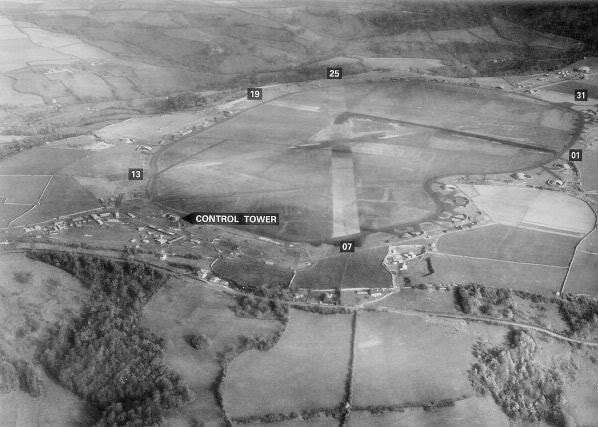 | ||
Operator Royal Air ForceUnited States Army Air Forces Location North of Swainswick, Somerset | ||
Raf charmy down airfield
Royal Air Force Charmy Down or RAF Charmy Down is a former Royal Air Force station in Somerset, England. The airfield is located approximately 3 miles (4.8 km) north-northeast of Bath; about 96 miles (154 km) west of London
Contents
- Raf charmy down airfield
- Raf charmy down control tower
- History
- Royal Air Force use
- United States Army Air Forces use
- 4th Tactical Air Depot
- 422d 423d and 425th Night Fighter Squadrons
- Postwar use
- Current use
- References

Opened in 1941 it was used by initially by the Royal Air Force and then later by the United States Army Air Forces. During the war it was used primarily as night fighter interceptor airfield. After the war it was closed in 1945.
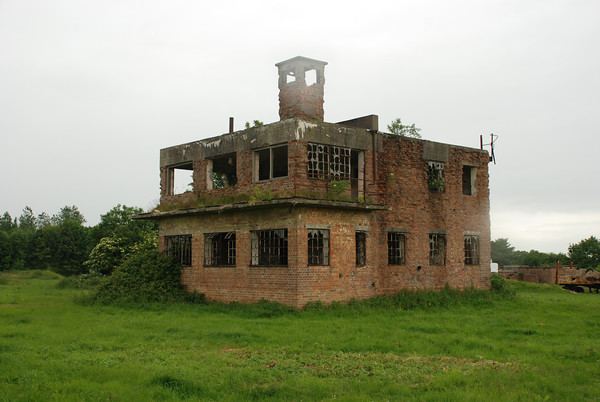
Today the remains of the airfield are located on private property being used as agricultural fields.
Raf charmy down control tower
History
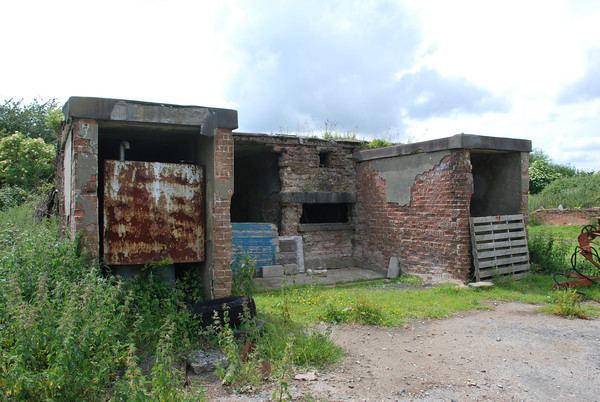
Built on a Kerbed Long barrow site, where a cremation urn was found, near a burial of a long necked beaker, and a bronze dagger, these are believed to be from the Beaker people. The Kerbed Long Barrows were then flattened to make way for the airfield.
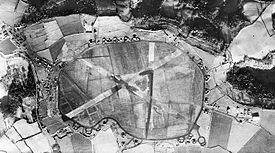
It was originally planned as a satellite for the Maintenance Unit at nearby RAF Colerne but by the time construction work started in 1940 it had been selected as a sector station by No. 10 Group of RAF Fighter Command.
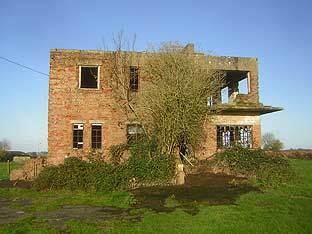
RAF Charmy Down was opened late in 1940 and originally had a grass surface with landing strips of 4,125 feet (1,257 m), both south east to north west and north east to south west. It was later upgraded to the Class A airfield standard set by the British Air Ministry in 1941, the main feature of which was a set of three converging runways each containing a concrete runway for takeoffs and landings, optimally placed at 60 degree angles to each other in a triangular pattern. In addition a 50 feet (15 m) wide tarmac perimeter track and 39 aircraft dispersal points was constructed. These were 12 double pens and 15 single standings.
The technical site was connected to the ground station and airfield consisted of 12 Blister hangars and one Bellman hangar and various organisational, component and field maintenance shops along with the maintenance personnel necessary to keep the aircraft airworthy and to quickly repair light and moderate battle damage. Depot personnel performed depot-level maintenance on aircraft as well as performing major structural repair on severely damaged combat aircraft. The Ammunition dump was located on the north side of the airfield, outside the perimeter track surrounded by large dirt mounds and concrete storage pens for storing the ammunition required by the aircraft.
Royal Air Force use
The first occupants of Charmy Down was No. 87 Squadron RAF, with night-fighting Hawker Hurricanes, In the summer of 1941 Boulton Paul Defiants appeared and Westland Whirlwinds and Turbinlite Havocs of 125 and 263 squadrons respectively were to be seen the following year. 137 Squadron replaced No 263 Squadron in September 1941. In November 1941 417 Squadron of the Royal Canadian Air Force was formed here.
During 1942 various other squadrons were posted to Charmy Down including 533 Squadron which was formed on 8 September 1942, from No. 1454 (Turbinlite) Flight, as part of No. 10 Group RAF in Fighter Command.
Instead of operating only Turbinlite and -rudimentary- Airborne Intercept (AI) radar equipped aircraft (Havocs and Bostons) and working together with a normal nightfighter unit, such as in their case with the Hawker Hurricanes of 87 Squadronin the Flight, the unit now also flew with their own Hurricanes. It was disbanded at Charmy Down on 25 January 1943, when Turbinlite squadrons were, due to lack of success on their part and the rapid development of AI radar, thought to be superfluous.
A Supermarine Spitfire Operational Training Unit took over in 1943 and stayed until the airfield was turned over to the USAAF in November 1943.
United States Army Air Forces use
Charmy Down was known as USAAF Station AAF 487 for security reasons by the USAAF during the war, and by which it was referred to instead of location. The airfield code/USAAF Station Code was "CH".
4th Tactical Air Depot
Service groups were deployed there late in 1943 to operate the 4th Tactical Air Depot, which was intended to repair, modify and maintain Allison-engined fighter types, primarily Lockheed P-38 Lightnings and North American P-51 Mustangs.
For unrecorded reasons, it was decided to transfer this operation to Kingston Bagpuize early in 1944, possibly for better local logistics and communications in the Oxford area. Nevertheless, IX Air Force Service Command activities continued at Charmy Down until the autumn of 1944.
422d, 423d and 425th Night Fighter Squadrons
The Ninth Air Force was scheduled to receive three night fighter squadrons with a mission to effect night air defence of US airfields when these were established on the Continent. RAF Charmy Down was selected as an airfield for these squadrons which would arrive individually, not as part of a group, and were to be equipped with the new Northrop P-61 Black Widow.
Personnel of the 422nd Night Fighter Squadron arrived first on 7 March 1944 and had their aircrews posted to various RAF night fighter and signal schools for theatre indoctrination. Meanwhile, as there was no sign of the P-61s. the pilots kept up their flight time on Cessna UC-78s and other communication types.
On 18 April 1944 the men of the 423d Night Fighter Squadron joined the 422nd at Charmy Down and their aircrew also undertook training at RAF installations white the wait for P-61s continued. On 6 May 1944 the 422nd NFS was sent to the RAF night fighter Operational Training Unit at RAF Scorton in North Yorkshire where they eventually received the first of their Black Widows later that month.
Meanwhile, the 423rd NFS continued to wait for aircraft at Charmy Down. As its aircrews had trained in the United States on the Douglas P-70, (the night-fighter version of the Douglas A-20 Havoc), in the absence of sufficient P-61s, the Ninth Air Force decided to use the 423rd personnel to form a night photographic unit equipped with A-20s. To this end, the 423rd NFS was assigned to the 10th Reconnaissance Group on 10 May 1944 and was redesignated as the 155th Photographic Reconnaissance Squadron. The squadron was transferred to RAF Chalgrove.
Soon after, on 26 May the third night fighter squadron, the 425th Night Fighter Squadron arrived at Charmy Down and underwent the same preliminary training as the 422nd and 423rd squadrons. On 12 June 1944 the squadron left to join the 422nd NFS at RAF Scorton where its aircrew were able to fly the P-61.
The original plan had been for all three night fighter squadrons to be on combat status with P-61s by D-Day, due to lack of equipment none of the squadrons or P-61s were ever stationed at Charmy Down.
Postwar use
After the end of hostilities in Europe, the airfield returned to the RAF. There was little flying from the station although it was not officially closed until October 1946. From the January 1946 to October 1946, No 92 Gliding School, Air Training Corps used the airfield and it was home to the Personnel Resettlement Centre for Australians.
In the 1950s, Charmy Down was included on a list of sites for the deployment of the ROTOR radar system; only preparatory work for the radar sites was ever completed.
Current use
With the facility released from military control, the airfield stood intact yet disused for many years. Eventually the hangars and runways were removed, but the outline of the runways can still be seen in aerial photography. Most of the perimeter track still remains mostly in a half-width condition, as do several of the derelict buildings, including the control tower, a few of the Blister hangars still remain and are used for farm storage.
Bath and North East Somerset Council has considered, but rejected, the option of building a Park and Ride for Bath on Charmy Down.
